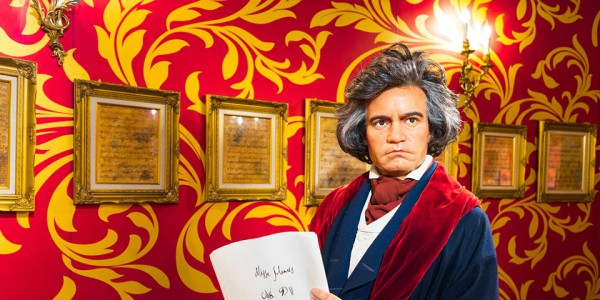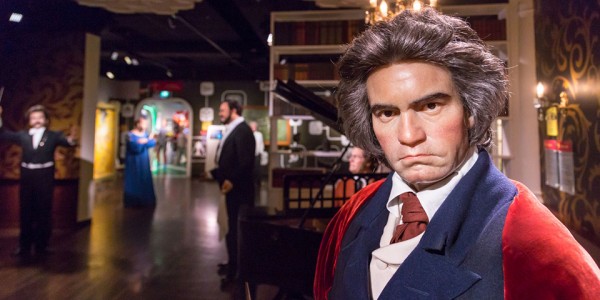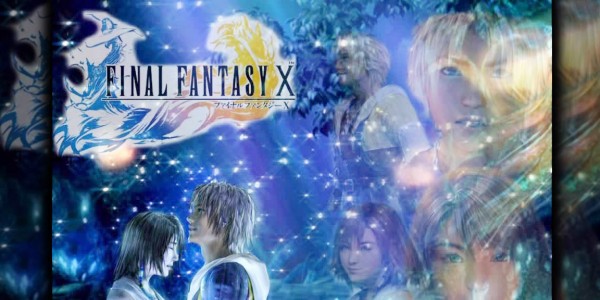Piano Pieces
Extremely difficult piano pieces #3 - Ravel's Gaspard de la Nuit is shockingly difficult and will give any pianist wanting to learn it nightmares for weeks to come. https://www.youtube.com/watch?v=hKgcHjq1xKQ

Extremely difficult piano pieces #2 - Liszt's Feux Follets really needs no introduction. It's really tough! (In truth, Liszt has even more difficult pieces than this one.)
https://www.youtube.com/watch?v=LsggmCF1Cys

Extremely difficult piano pieces #1 - Balakirev's Islamey is considered one of a handful of very difficult piano pieces. Listen and gawk at the playing expertise required for this one.

The Judges were full of praise for this talented family of musicians following their fabulous audition.

Lord Vinheteiro accompanied a gameplay of Sonic The Hedgehog, playing the Sonic songs and making their sound effects!!

Nora, the Piano Cat.

This is addictive! ??

|
|
Saw the pianist smiled at 1:18 mark there. Nice!! |
I've always known this piece by Emil Chau. Didn't know it has a Japanese origin!!

|
|
Btw, my favourite has been 风雨无阻! Hahaha! |
|
|
Siew Tin, are you taking formal lessons now? I noticed you have played so many pieces, when I looked at your profile. |
|
|
Yes. Mi try no play repeat pc during ?meetup^+^ |
|
|
That's really an impressive "personal rule" you have. No wonder you've a long list of pieces!! ? |
Thank you, Tea Zhi Yuan, for your contribution of this article.
"One instrumental development in Beethoven’s reign was the development of piano music and hence, the development of his piano sonatas. It is in my opinion that it is in these 32 that we see a beautiful series, each sonata carrying a crucial role in the evolution of music. And if we ever compare the 1st and 32nd sonata he wrote, it would seem that 2 different people have composed them."
... See More
Thank you, Tea Zhi Yuan, for your contribution of this article.
"One instrumental development in Beethoven’s reign was the development of piano music and hence, the development of his piano sonatas. It is in my opinion that it is in these 32 that we see a beautiful series, each sonata carrying a crucial role in the evolution of music. And if we ever compare the 1st and 32nd sonata he wrote, it would seem that 2 different people have composed them."
|
|
My personal favourite is Sonata No. 17 in D minor, the 3rd movement. Simple motif but engaging. |
|
|
Hi Soo Hin. Thank you for your reply. Yes, it is a simple and engaging motif and i believe that would be the tempest sonata. Ah, but unfortunately, I do have some prejudice or I guess "some beef"... See More Hi Soo Hin. Thank you for your reply. Yes, it is a simple and engaging motif and i believe that would be the tempest sonata. Ah, but unfortunately, I do have some prejudice or I guess "some beef" with that particular sonata (which explains why I didnt include it in any of the articles). But we have own preferences and the right to preference (some say that my personal favourite sonata, the Appasionata and particularly the 3rd movement sounds like a mouthful of notes that is not constructive, and I thought this should be applied to Liszt). |
|
|
Zhi Yuan, we are all open to discussions. ? Would you like to share why you have "some beef" with Tempest? |
|
|
Hi Soo Hin. I think it for that sonata, i feel it is just a mouthful of notes especially so for the development of the 3rd movement, a style that is evident in most of his middle sonatas. All of a... See More Hi Soo Hin. I think it for that sonata, i feel it is just a mouthful of notes especially so for the development of the 3rd movement, a style that is evident in most of his middle sonatas. All of a sudden everything sounds unconstructive. Yeah... i dont think its the best thing he has written and i dont particularly enjoy pieces with the same characteristic (Hint Hint Liszt Sonata) |
Thank you, Tea Zhi Yuan, for your contribution of this article.
"Since Beethoven’s time, the face of music changed forever. Beethoven made it possible for one to break the traditions of music. And by casting away the dogmatic conventional approaches of music from the past, great composers after Beethoven (many of whom modeled their own compositions after Beethoven) carried on his legacy of musical innovation. Other composers too inspired others to push the boundaries of music and the... See More
Thank you, Tea Zhi Yuan, for your contribution of this article.
"Since Beethoven’s time, the face of music changed forever. Beethoven made it possible for one to break the traditions of music. And by casting away the dogmatic conventional approaches of music from the past, great composers after Beethoven (many of whom modeled their own compositions after Beethoven) carried on his legacy of musical innovation. Other composers too inspired others to push the boundaries of music and the cycle of inspiration goes on and on till present times. And true enough, the cycle will still continue; the music of today: Pop, Rap etc. will irrevocably inspire a new music movement."
|
|
Wa.. Mr Tea, thanks! Enjoyed reading both of your articles. Btw, what's "Tea" in Chinese? Hehe. |
|
|
Hi Mabel. Glad that you enjoyed the articles. haha. you have to be the millionth person to ask me for my chinese surname! Care to take a guess? hint its not 茶 |
|
|
Closest I can think of is "Tay", so I guess it's Zheng? |
|
|
Bingo:))) yeah my chinese surname is zheng. |
The Chinese New Year (农历新年) is a very important festival that is celebrated by the Chinese populations in many Asian countries, like Singapore, Malaysia, China, Hong Kong, Taiwan, Thailand, Cambodia, Indonesia, Mauritius, and Philippines. During the celebrations, many popular Chinese New Year songs are sung, including "Gong Xi Gong Xi" (恭喜恭喜). The fact that it uses the minor key is the oddity, because minor key songs typically project sadness and loneliness. Why is Gong Xi Gong Xi written in... See More
The Chinese New Year (农历新年) is a very important festival that is celebrated by the Chinese populations in many Asian countries, like Singapore, Malaysia, China, Hong Kong, Taiwan, Thailand, Cambodia, Indonesia, Mauritius, and Philippines. During the celebrations, many popular Chinese New Year songs are sung, including "Gong Xi Gong Xi" (恭喜恭喜). The fact that it uses the minor key is the oddity, because minor key songs typically project sadness and loneliness. Why is Gong Xi Gong Xi written in the minor key then?
|
|
wa, this is wow! I've taken this song for granted, did not know it has a dark past. |
|
|
This 1946 audio of 恭喜恭喜 sure doesn't sound happy at all - https://www.youtube.com/watch?v=f2oXuzvbGuA |
|
|
Gavin, oh my.. it sounds really unlike the happy CNY song we always know. ? |
Looking for a FREE 550+ page book of classical masterpieces? Try this link at IMSLP.
Alternatively, you could go to the Esplanade Library, borrow this truly heavy book and heft it to a Pianover Meetup.
|
|
Here are another few IMSLP gems: Here are another few IMSLP gems: |
|
|
I'm amazed! How did you find all these? |
|
|
I got tired of downloading individual pieces and started looking for collections or anthologies on IMSLP. Plus I actually carried a 550 page book from the Esplanade to URA Centre, so I am NOT... See More I got tired of downloading individual pieces and started looking for collections or anthologies on IMSLP. Plus I actually carried a 550 page book from the Esplanade to URA Centre, so I am NOT doing that again. And while I'm at it, why not share. |
Thank you Gavin for contributing this article.
"Video game music transited through several phases. Chiptunes were predominant in the 80s, while the 90s brought digitally synthesized music, MIDI, and pre-recorded music that could be streamed during gameplay. Today, video game music has matured like fine wine; you can now have beautiful soundtracks presented with a full orchestra and even couple that with Dolby Stereo playback. This first part shall explore some of the music from the... See More
Thank you Gavin for contributing this article.
"Video game music transited through several phases. Chiptunes were predominant in the 80s, while the 90s brought digitally synthesized music, MIDI, and pre-recorded music that could be streamed during gameplay. Today, video game music has matured like fine wine; you can now have beautiful soundtracks presented with a full orchestra and even couple that with Dolby Stereo playback. This first part shall explore some of the music from the role-playing game genre."
|
|
Yayy!! Looking forward!! Woww.. is the 3rd article related to this topic? |
|
|
Not at all. |
|
|
Hehehe, good time to reveal the title? |
|
|
It's something to do with the "Piano Concerto". |

|
|
That would be music by Danny Elfman. If I can dig music from The Simpsons, then I must say I will love this piece too. If you google the right words, you can even... See More That would be music by Danny Elfman. If I can dig music from The Simpsons, then I must say I will love this piece too. If you google the right words, you can even download it. |
|
|
❤music expresses what words cannot say |
|
|
Hahaha, I'm still not competent enough to play it. Will work hard towards it! Meanwhile, Gavin and Jia hui, you both can play during the pianovers meetup! ? |
One of my favourite piano pieces - Eyes On Me, from Final Fantasy 8. ?
Loves Faye Wong's voice for this piece too.

|
|
I have played some FF7 a long time back and just a bit of FF8 (as a preview). Can't wait to finish playing them once again. |
|
|
I see. Haha. I don't play Final Fantasy. Only know of this game because of Eyes On Me. |
|
|
Same, Mabel, I also don't play this game. Didn't even know it was from final fantasy. hehehe. |
|
|
I went to check out some songs from the Final Fantasy series after I read this post. I think To Zanarkand is great too! Suteki da ne from FF10 as well. Great to share pieces here. I get to know... See More I went to check out some songs from the Final Fantasy series after I read this post. I think To Zanarkand is great too! Suteki da ne from FF10 as well. Great to share pieces here. I get to know some interesting pieces from the sharing. Keep it up!! =) |
It is amazing that four decades after the movie’s release, people are still finding new ways of interpreting Halloween’s theme song. The original theme was created with simple piano music, however, sometimes it is simple things that really capture people’s imagination and withstand the test of time. As John Carpenter said, “Horror movies will live forever.”
|
|
You watched the movie? Quite an old show. |
|
|
Nay.. I didn't watch. I avoid horror shows. I run away! I guess you did? |
|
|
I didn't as well. But I'm familiar with this famous title. Just like how I know the existence of Lord of the Rings, but I have never watched them. |
|
|
My first time with this piece! ? |
Piano Piece Pick #14 - Looking to perform for a wedding, but yet you have been requested to perform something other than the standard Wedding March (Mendelssohn) and Bridal Chorus (Wagner). And you have been further instructed to avoid overused romantic pieces like Canon in D (Pachelbel), Claire de Lune (Debussy), Ave Maria (J S Bach), and Ode to Joy (Beethoven).
So, what will you perform at this wedding? I recommend "Wedding Day at Troldhaugen" from Edvard Grieg. It is the last... See More
Piano Piece Pick #14 - Looking to perform for a wedding, but yet you have been requested to perform something other than the standard Wedding March (Mendelssohn) and Bridal Chorus (Wagner). And you have been further instructed to avoid overused romantic pieces like Canon in D (Pachelbel), Claire de Lune (Debussy), Ave Maria (J S Bach), and Ode to Joy (Beethoven).
So, what will you perform at this wedding? I recommend "Wedding Day at Troldhaugen" from Edvard Grieg. It is the last piece from Volume 8 of Grieg's Lyric Pieces (a large collection of 66 solo pieces). Click on the video below to listen!
No? A bad choice, you say? So, what would YOU recommend we play at this wedding other than the pieces listed here?
Video: https://www.youtube.com/watch?v=gq83dUB37rI
Score: https://imslp.org/wiki/Special:ImagefromIndex/285710/ft01

|
|
No, I don't think so. Canon in D doesn't sound that nice on the piano, not without some strings backing. |
|
|
Most gals would melt with Canon in D, even just piano alone!! ? |
|
|
Yes Mabel, I will melt... ? Gavin, to me, I don't think this song is suitable for a wedding here in SG leh. Hehehe, just my personal opinion, at least for my wedding. |
|
|
Ok... majority wins, I suppose! ? |
Piano Piece Pick #15 - With the evil clown "It" terrorizing cinema goers, it is perhaps never a better time then to think about addressing people's coulrophobia, or fear of clowns.
What about learning how to play the tune that started it all for the world of the Ringling Brothers, and Barnum & Bailey Circus? And, that would be Czech composer Julius Fučík's Entrance of the Gladiators (Op 68). The march gained popularity in circuses after it was arranged for wind bands and... See More
Piano Piece Pick #15 - With the evil clown "It" terrorizing cinema goers, it is perhaps never a better time then to think about addressing people's coulrophobia, or fear of clowns.
What about learning how to play the tune that started it all for the world of the Ringling Brothers, and Barnum & Bailey Circus? And, that would be Czech composer Julius Fučík's Entrance of the Gladiators (Op 68). The march gained popularity in circuses after it was arranged for wind bands and published as "Thunder and Blazes". Today, it is played to introduce clowns.
So, let's "Send in the Clowns". Click and listen!
https://www.youtube.com/watch?v=_B0CyOAO8y0
http://imslp.org/wiki/Category:Fu%C4%8D%C3%ADk,_Julius

|
|
Playmobil evades copyright issues by composing "this song using different notes but of the same style"! Give it a listen! ... See More Playmobil evades copyright issues by composing "this song using different notes but of the same style"! Give it a listen! |
|
|
Laugh out loud! Yes, it is a rip off of Fučík's march. But, I don't think you can get away scot free in today's music industry; you will very likely get sued if there are derivative similarities... See More Laugh out loud! Yes, it is a rip off of Fučík's march. But, I don't think you can get away scot free in today's music industry; you will very likely get sued if there are derivative similarities. |
Piano Piece Pick #13 - Claude Debussy wrote a 6 piece suite for children back in 1908. The final piece of the set contained this peculiar title - "Golliwogg's cake-walk". But, what does the title mean?
Well, a golliwogg is a stuffed rag doll characterized by white-rimmed eyes, clown-like lips, and frizzy black hair and skin. The cakewalk is a dance invented by slaves to make fun of the elite class; often slaves would dance against each other to win a delicious hoecake (southern... See More
Piano Piece Pick #13 - Claude Debussy wrote a 6 piece suite for children back in 1908. The final piece of the set contained this peculiar title - "Golliwogg's cake-walk". But, what does the title mean?
Well, a golliwogg is a stuffed rag doll characterized by white-rimmed eyes, clown-like lips, and frizzy black hair and skin. The cakewalk is a dance invented by slaves to make fun of the elite class; often slaves would dance against each other to win a delicious hoecake (southern cornbread).
Debussy's Golliwogg's cake-walk invokes an image of black dolls dancing in mocking fun and the music borrows elements from ragtime and jazz. And boy, doesn't that distinctive melody take the cake?

Piano Piece Pick #12 - With Christmas just 20 days away, it's time to prepare a piece for that all important recital. Why not pick something jazzy this year?
Mel Tormé's The Christmas Song is etched indelibly in our minds with its famous opening lyrics - "Chestnuts roasting on an open fire. Jack Frost nipping at your nose." The song becomes extra special however when it gets that special jazz treatment.
Plus there are other Christmas jazz songs as well, so maybe we'll hear one... See More
Piano Piece Pick #12 - With Christmas just 20 days away, it's time to prepare a piece for that all important recital. Why not pick something jazzy this year?
Mel Tormé's The Christmas Song is etched indelibly in our minds with its famous opening lyrics - "Chestnuts roasting on an open fire. Jack Frost nipping at your nose." The song becomes extra special however when it gets that special jazz treatment.
Plus there are other Christmas jazz songs as well, so maybe we'll hear one this year at Pianovers Meetup #64?
Video: https://www.youtube.com/watch?v=QqHOG9KSYAg
Score: Available in Musescore

Piano Piece Pick #11 - Following on the études from the last article, today I introduce a set of 7 Virtuoso Études from Earl Wild. This set are virtuosic transcriptions of George Gershwin's popular songs and include I got Rhythm, Oh Lady be Good, Liza, Embraceable You, Somebody Loves me, Fascinatin' Rhythm, and The Man I Love.
If you are up to this fresh challenge, take the plunge on the Wild side and try your hand at one of these well-loved songs from Gershwin. You will meet... See More
Piano Piece Pick #11 - Following on the études from the last article, today I introduce a set of 7 Virtuoso Études from Earl Wild. This set are virtuosic transcriptions of George Gershwin's popular songs and include I got Rhythm, Oh Lady be Good, Liza, Embraceable You, Somebody Loves me, Fascinatin' Rhythm, and The Man I Love.
If you are up to this fresh challenge, take the plunge on the Wild side and try your hand at one of these well-loved songs from Gershwin. You will meet polyrhythms, demanding scales and arpeggios, staccato playing, brilliant jazz rhythms and more.
Video - https://www.youtube.com/watch?v=wYJY2glnyL0
Score - Available by Googling for "wild gershwin sheet pdf"

Piano Piece Pick #10 - Bela Bartok's Six Dances in Bulgarian Rhythm feature some of the most peculiar time signatures in piano pieces that you are ever likely to encounter.
In actual fact, these six pieces make up the last 6 of a set of 153 pieces from the Mikrokosmos collection, études ranging from very very easy, leading all the way up to fiendishly difficult. So, there is something for everyone here.
#148 is 4 + 2 + 3 quavers in each bar
#149 is 2 + 2 + 3 quavers in... See More
Piano Piece Pick #10 - Bela Bartok's Six Dances in Bulgarian Rhythm feature some of the most peculiar time signatures in piano pieces that you are ever likely to encounter.
In actual fact, these six pieces make up the last 6 of a set of 153 pieces from the Mikrokosmos collection, études ranging from very very easy, leading all the way up to fiendishly difficult. So, there is something for everyone here.
#148 is 4 + 2 + 3 quavers in each bar
#149 is 2 + 2 + 3 quavers in each bar
#150 is 5 quavers in each bar
#151 is 3 + 2 + 3 quavers in each bar
#152 is 2 + 2 + 2 + 3 quavers in each bar
#153 is 3 + 3 + 2 quavers in each bar
Listen to Bartok playing Bartok and share your opinions below.
https://www.youtube.com/watch?v=Cj306a_qTPk
Score: http://imslp.eu/files/imglnks/euimg/2/21/IMSLP465640-PMLP3661-Bela_Barto...

Piano Piece Pick of the Day #9 - 彩云追月 (Cǎi Yún Zhuī Yuè), or translated as "Colourful Clouds Chasing the Moon", is a piece composed by 任光 (Rén Guāng) back in 1932.
Imagine a scene of the night sky filled with multi-coloured clouds trying to play catch with the moon. And to that visual picture, coupled with a modern cosmopolitan beat, singer 爱戴 (Ài Dài or Edell) added poetic lyrics to the song in 2003 for her album "Love"; she sings it both in Cantonese and Mandarin.
Listen to... See More
Piano Piece Pick of the Day #9 - 彩云追月 (Cǎi Yún Zhuī Yuè), or translated as "Colourful Clouds Chasing the Moon", is a piece composed by 任光 (Rén Guāng) back in 1932.
Imagine a scene of the night sky filled with multi-coloured clouds trying to play catch with the moon. And to that visual picture, coupled with a modern cosmopolitan beat, singer 爱戴 (Ài Dài or Edell) added poetic lyrics to the song in 2003 for her album "Love"; she sings it both in Cantonese and Mandarin.
Listen to three versions of the song below:
Lang Lang's - https://www.youtube.com/watch?v=A3JT5giyVMM
Li Yundi's - https://www.youtube.com/watch?v=Z-EZTdVJmVQ
Edell's - https://www.youtube.com/watch?v=-PQr3qnly80
Score: Follow the link found in the Youtube description for the version performed by Lang Lang.

Piano Piece Pick of the Day #8 - Today's focus is shifting gears to bring you something from mother Russia. Entitled Дорогой длинною (or pronounced "Daroguy D'lina-you). This piece is simple to play and famous the world over, including Singapore. It's a great piece for children or adult beginners, plus it makes a great cultural crossover.
The song has been covered by many other singers including Bing Crosby, Roger Whittaker, Dolly Parton, and even sampled by 50 Cent in "When it rains... See More
Piano Piece Pick of the Day #8 - Today's focus is shifting gears to bring you something from mother Russia. Entitled Дорогой длинною (or pronounced "Daroguy D'lina-you). This piece is simple to play and famous the world over, including Singapore. It's a great piece for children or adult beginners, plus it makes a great cultural crossover.
The song has been covered by many other singers including Bing Crosby, Roger Whittaker, Dolly Parton, and even sampled by 50 Cent in "When it rains it pours". Originally composed by Boris Fomin, Eugene Raskin penned the English lyrics, and Welsh singer Mary Hopkin actually made it famous in 1968.
No guesses for what this song is. Just listen to it below (preferably the Russian version - sung by Sergey Lazarev):
Russian: https://www.youtube.com/watch?v=CmRynue6_MA
English: https://www.youtube.com/watch?v=y3KEhWTnWvE
Score: https://xa.yimg.com/kq/groups/20774692/164648859/name/Those+Were+The+Day...

|
|
The irony here is that the Russian and English lyrics have not that much in common. The former called "By the Long Road" is a romantic gypsy song, whereas the latter "Those were the Days" is more... See More The irony here is that the Russian and English lyrics have not that much in common. The former called "By the Long Road" is a romantic gypsy song, whereas the latter "Those were the Days" is more a celebration of life. The saddest thing though for the Russian version was that romantic songs were eventually banned in Russia back in 1929. Poor Boris (the composer) eventually went to prison in 1937 for his songs and much later on died from tuberculosis in 1948. But in between, Boris had to endure the shame of composing songs that were considered anti-socialist in nature! |
|
|
@Zensen: Helmut Lotti's singing shows us that he is quite a smooth crooner whereas Sergey Lazarev's singing tends to be more flamboyant. What can I say, I like both performances! |
|
|
Yes! And I''m impressed that Mabel knows this song despite being so young! |
|
|
Zensen, it's in one of those Alfred learning books for beginners! ? |
Piano Piece Pick of the Day #7 - The Adagio of Spartacus and Phrygia from Act Two of the ballet Spartacus by Aram Khachaturian probably needs no introduction.
To find a great piano transcription that does it justice while bringing out the beautiful love theme however, can be quite a task. But, I have recently found one on the web (possibly by Emin Khachaturian, Aram's nephew) and wanted to share it with all here. Enjoy!
I was playing this piece earlier (after watching an... See More
Piano Piece Pick of the Day #7 - The Adagio of Spartacus and Phrygia from Act Two of the ballet Spartacus by Aram Khachaturian probably needs no introduction.
To find a great piano transcription that does it justice while bringing out the beautiful love theme however, can be quite a task. But, I have recently found one on the web (possibly by Emin Khachaturian, Aram's nephew) and wanted to share it with all here. Enjoy!
I was playing this piece earlier (after watching an encore of 童话 by Eng Wee at the URA Centre), and I must say that the Adagio of Spartacus and Phryigia is quite a challenge for the uninitiated, but definitely navigable for experienced sight readers.

|
|
The score for the Adagio is here |
|
|
I prefer the original orchestral version whereby during the climax, the strings play in triple-diap (octaves) layers for the main melody while the trumpets play the counter melody. My friend... See More I prefer the original orchestral version whereby during the climax, the strings play in triple-diap (octaves) layers for the main melody while the trumpets play the counter melody. My friend Martin calls it, "Emotional Peak"! |
|
|
Though this piano solo arrangement/transcription adheres largely to the piece, during the climax it falls short of one important counter melody (from 5:20 to 5:22), namely the notes G#, highF then... See More Though this piano solo arrangement/transcription adheres largely to the piece, during the climax it falls short of one important counter melody (from 5:20 to 5:22), namely the notes G#, highF then B (originally by the trumpets). |
|
|
Well, I guess you can't win them all with piano reductions. Or, maybe you could add in the counter melody yourself. But I am guessing it is a balance of wanting a transcription to be... See More Well, I guess you can't win them all with piano reductions. Or, maybe you could add in the counter melody yourself. But I am guessing it is a balance of wanting a transcription to be accurate vs the transcription being playable by pianists. Which was why the counter melody was not added. |





The killer difficulty really comes after 29 seconds.